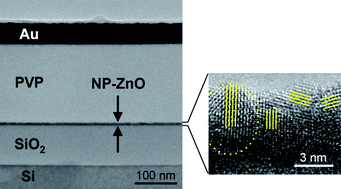Morphological impact of zinc oxide layers on the device performance in thin-film transistors†
Abstract

* Corresponding authors
a
Organic Materials & Devices (OMD), Dept. of Materials Science, University Erlangen-Nürnberg, Martensstraße 07, Erlangen, Germany
E-mail:
hendrik.faber@ww.uni-erlangen.de
b
Institute of Particle Technology, Dept. of Chemical and Biological Engineering, University Erlangen-Nürnberg, Cauerstraße 04, Erlangen, Germany
E-mail:
w.peukert@lfg.uni-erlangen.de
c
Center for Nanoanalysis and Electron Microscopy (CENEM), Dept. of Materials Science, University Erlangen-Nürnberg, Cauerstraße 06, Erlangen, Germany
E-mail:
erdmann.spiecker@ww.uni-erlangen.de

 Please wait while we load your content...
Something went wrong. Try again?
Please wait while we load your content...
Something went wrong. Try again?
H. Faber, M. Klaumünzer, M. Voigt, D. Galli, B. F. Vieweg, W. Peukert, E. Spiecker and M. Halik, Nanoscale, 2011, 3, 897 DOI: 10.1039/C0NR00800A
To request permission to reproduce material from this article, please go to the Copyright Clearance Center request page.
If you are an author contributing to an RSC publication, you do not need to request permission provided correct acknowledgement is given.
If you are the author of this article, you do not need to request permission to reproduce figures and diagrams provided correct acknowledgement is given. If you want to reproduce the whole article in a third-party publication (excluding your thesis/dissertation for which permission is not required) please go to the Copyright Clearance Center request page.
Read more about how to correctly acknowledge RSC content.
 Fetching data from CrossRef.
Fetching data from CrossRef.
This may take some time to load.
Loading related content
